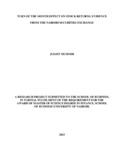Turn of the month effect on stock returns: evidence from the nairobi securities exchange
| dc.contributor.author | Musimbi, Juliet | |
| dc.date.accessioned | 2016-04-21T12:10:56Z | |
| dc.date.available | 2016-04-21T12:10:56Z | |
| dc.date.issued | 2015 | |
| dc.identifier.uri | http://hdl.handle.net/11295/94624 | |
| dc.description.abstract | The security market faces inconsistency in prices due to various reasons and at different periods. The drifts in prices allow investors capitalize on the abnormal profits showing markets are not as efficient as depicted by Fama. This gap led to the identification of various calendar anomalies including the Turn-of-the-Month anomaly which is a calendar anomaly that suggests temporal increase in security prices during the last few days and the first few days of each month. This study was focused on establishing the effect exists at the Nairobi Securities exchange and which turn-of-the-month window maximizes returns. The study adopted an events study approach. This approach was appropriate since the turn-of-the-month is an occurrence experienced on a continuous basis. The study used Nairobi Securities Exchange data on share prices for the 65 listed companies from 2010 to 2014. A paired t-test was conducted to test if there was a significant difference in mean abnormal returns between the turn of the month period and the rest of the month. The findings showed that the existence of the turn-of-the-month anomaly varies between periods and study windows with the 5 days turn-of-the-month window showing the most significant results. The period 2013 showed a maximum difference in the abnormal returns suggesting a unique occurence. On the overall, the effects offset to minimum significance thereby implying minimal difference in returns between the mean abnormal returns at the beginning of the month and the rest of the month hence failure to confirm the anomaly exists. The study recommends that investors study the market to establish the market trends and develop portfolios that will maximize returns in the long-run considering stock returns are influenced by factors influencing the market like systematic risk factors which may lead to poor performance of some stocks. | en_US |
| dc.language.iso | en | en_US |
| dc.subject | Month effect on stock returns | en_US |
| dc.title | Turn of the month effect on stock returns: evidence from the nairobi securities exchange | en_US |
| dc.type | Thesis | en_US |

